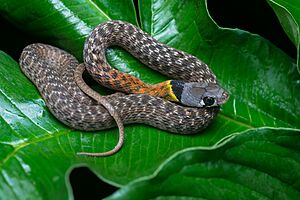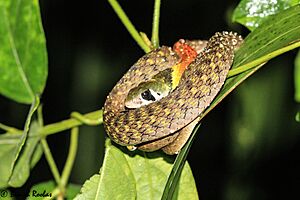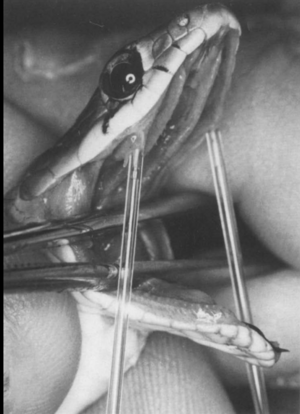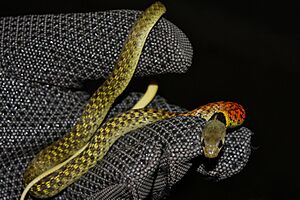Red-necked keelback facts for kids
Quick facts for kids Red-necked keelback |
|
|---|---|
 |
|
| Conservation status | |
| Scientific classification | |
| Genus: |
Rhabdophis
|
| Species: |
subminiatus
|
| Synonyms | |
|
|
The red-necked keelback (scientific name: Rhabdophis subminiatus) is a type of snake found in Asia. It is known for its bright colors and is a venomous snake. This snake belongs to a group called Colubridae, which includes many different kinds of snakes.
Contents
What Does It Look Like?
The red-necked keelback snake usually has a greenish body. It also has bright red and yellow colors near its head and neck. These snakes can grow to be about 70 to 90 centimeters (27 to 35 inches) long. Female snakes are often much bigger than males. When they mate, sometimes several male snakes will gather around one female.
Where It Lives and What It Eats
You can often find the red-necked keelback snake living near ponds. This is because its favorite foods, frogs and fish, live there. It's a skilled hunter in watery areas.
Snakebite and Venom Safety
The red-necked keelback is a "rear-fanged" snake. This means its venom-delivering teeth are located at the back of its mouth. For a long time, people thought this snake was harmless to humans. However, after some serious bites, scientists studied its venom more closely. They found out it is actually quite dangerous.
Rear-fanged snakes need to bite and hold on, or bite many times, to get their venom into a person. The snake has two larger teeth at the back of its upper jaw. It also has a special gland, called Duvernoy's gland, which makes a very strong venom.
What Happens After a Bite?
When this snake bites, its venom flows into the bite marks made by its back teeth. This venom can cause serious problems. Some effects include internal bleeding, feeling sick to your stomach (nausea), and problems with blood clotting. In some cases, it can even affect the kidneys.
It's very important to be careful if someone is bitten by a red-necked keelback. Doctors need to know about the bite. It's also advised not to give injections or cause more injury, as this could make bleeding worse. While most bites from the front teeth are not serious, rare bites from the rear fangs can be very dangerous.
Scientists have studied the venom and found it strongly affects how blood clots. Because of its powerful venom, the red-necked keelback snake has been added to lists of dangerous wild animals in some places.
Why Is It Called That?
The name subminiatus comes from a word that means "scarlet" or "vermilion." This refers to the reddish color often seen on the snake's neck. Sometimes, this red color spreads further down its body.
Where Can You Find It?
The red-necked keelback snake lives in many parts of Asia, including:





